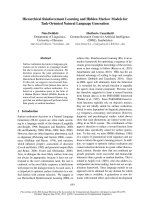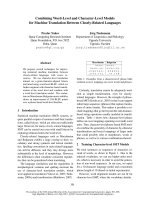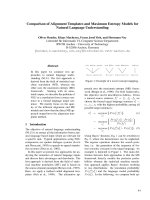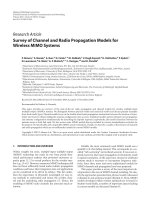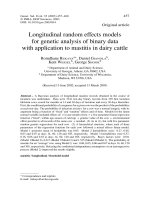Inference and intervention causal models for business analysis
Bạn đang xem bản rút gọn của tài liệu. Xem và tải ngay bản đầy đủ của tài liệu tại đây (5.5 MB, 276 trang )
Inference and Intervention
Ryall and Bramson’s Inference and Intervention is the first textbook on causal modeling
with Bayesian networks for business applications. In a world of resource scarcity, a
decision about which business elements to control or change – as the authors put it,
a managerial intervention – must precede any decision on how to control or change
them, and understanding causality is crucial to making effective interventions.
The authors cover the full spectrum of causal modeling techniques useful for the
managerial role, whether for intervention, situational assessment, strategic decisionmaking, or forecasting. From the basic concepts and nomenclature of causal modeling
to decision tree analysis, qualitative methods, and quantitative modeling tools, this
book offers a toolbox for MBA students and business professionals to make successful
decisions in a managerial setting.
Michael D. Ryall is an Associate Professor of Strategy at the University of Toronto. He
holds a PhD in economics from the University of California, Los Angeles and an MBA
from the University of Chicago. He is President of the Strategy Research Initiative, a
scholarly society dedicated to the advancement of research in the field of management.
His primary research interest is the game-theoretic foundations of business strategy and
his work has been published in leading international journals. Ryall teaches courses on
advanced strategy analysis and on causal modeling to undergraduate, MBA and EMBA
students. Prior to obtaining a PhD and becoming a full-time scholar, he held positions
in consulting, general management and finance.
Aaron L. Bramson received a PhD from the University of Michigan in 2012 in
a joint program with the departments of political science and philosophy, as well
as earning UM’s graduate certificate in complexity in 2008. He holds an MS in
mathematics from Northeastern University, as well as a BS in economics and a BA
in philosophy from the University of Florida. Aaron’s research specialty is complexity
science, methodology for modeling complex systems, and measuring dynamics in large
datasets. He is currently a researcher at the RIKEN Brain Science Institute in Japan.
Previously, he worked as a research fellow in the Rotman School of Management at
the University of Toronto, as a software engineer at Lockheed Martin Corporation, and
has taught numerous workshops on complexity, networks, and agent-based modeling
around the world.
This page intentionally left blank
Inference and
Intervention
Causal Models for Business Analysis
Michael D. Ryall &
Aaron L. Bramson
First published 2014
by Routledge
711 Third Avenue, New York, NY 10017
Simultaneously published in the UK
by Routledge
2 Park Square, Milton Park, Abingdon, Oxon OX14 4RN
Routledge is an imprint of the Taylor & Francis Group, an informa business
© 2014 Taylor & Francis
The right of Michael Ryall & Aaron Bramson to be identified as the authors of this
work has been asserted by them in accordance with sections 77 and 78 of the
Copyright, Designs and Patents Act 1988.
All rights reserved. No part of this book may be reprinted or reproduced or utilised
in any form or by any electronic, mechanical, or other means, now known or
hereafter invented, including photocopying and recording, or in any information
storage or retrieval system, without permission in writing from the publishers.
Trademark notice: Product or corporate names may be trademarks or registered
trademarks, and are used only for identification and explanation without intent to
infringe.
Library of Congress Cataloging in Publication Data
Ryall, Michael D.
Inference and intervention : causal models for business analysis /
Michael D. Ryall & Aaron L. Bramson.
pages cm
Includes bibliographical references and index.
1. Decision making–Mathematical models. 2. Decision making–Statistical
methods. 3. Business planning–Statistical methods. I. Bramson, Aaron L. II. Title.
HD30.23.R92 2013
658.4’0101519542–dc23
2013005927
ISBN: 978-0-415-65759-4 (hbk)
ISBN: 978-0-415-65760-0 (pbk)
ISBN: 978-0-203-07683-5 (ebk)
Typeset in Berling
by Cenveo Publisher Services
Contents
List of Figures
Acknowledgments
1
2
Introduction to Causal Analysis
1
1.1
1.2
1
4
Situational Assessment
Managerial Intervention
Qualitative Causal Models
2.1
2.2
2.3
3
ix
xiii
Setting the Stage
Building a Qualitative Causal Model
2.2.1 Nodes
2.2.2 Links
2.2.3 Some Examples of Qualitative Causal Models
Causal Independence
2.3.1 Serial Triplets
2.3.2 Diverging Triplets
2.3.3 Converging Triplets
2.3.4 Causal Independence in General
Application: Interview Case Study
3.1
3.2
3.3
Getting Started
Focus on the Significant Drivers
Seek Sources of Common Problems
14
15
17
17
19
25
31
32
33
34
36
44
47
52
56
vi
Contents
3.4
3.5
3.6
4
59
61
62
62
65
71
71
73
75
75
Quantitative Causal Models
78
4.1
78
78
79
81
83
84
85
86
86
89
90
91
93
94
96
97
100
4.2
4.3
4.4
5
Ask Specific Questions
3.4.1 Administrative Staff
3.4.2 Service Staff
3.4.3 Doctors: Generalists and Specialists
Bring it All Together
Provide Specific Recommendations
3.6.1 Upgrade Account Management System
3.6.2 Adjust to an Aging Population
3.6.3 Appeal to a Younger Crowd
3.6.4 Final Note
Probability Basics
4.1.1 Variable States
4.1.2 Events
4.1.3 Probabilities
4.1.4 Conditional Probabilities
4.1.5 Joint Probabilities
4.1.6 System States
4.1.7 Bayes’ Rule
Quantifying a Qualitative Model
4.2.1 More Refined Approximations
Working with Quantitative Models
4.3.1 Probabilities from Count Data
4.3.2 Joint Probability Tables
4.3.3 The Complete Advertising Model
4.3.4 System-Level Joint Distribution & Factorization
4.3.5 Marginalization
The Move to Causal Models
Situational Analysis
5.1
5.2
Marginal from Conditional Probabilities
5.1.1 Serial Connections
5.1.2 Diverging Connections
5.1.3 Converging Connections
Evidence & Inference in Causal Models
5.2.1 Serial Connection
109
111
111
112
113
114
115
Contents
5.2.2
5.2.3
Divergent Connection
Convergent Connection
6 Application: Modeling Business Financials
6.1
6.2
6.3
6.4
The Spreadsheet Approach
Building a Causal Model
Marketing Uses the “Prosecutor’s Fallacy”
Green Ink Creates Simpson’s Paradox
7 Single-Agent Interventions
7.1
7.2
vii
121
123
132
134
135
143
146
151
One Decision, No Information
Multiple Decisions with Information
7.2.1 The Extended Model
7.2.2 General Solution Procedure
152
153
154
156
8 Application: Disrupting the Taxi Business
176
8.1
8.2
8.3
An Allocation of Resources Decision
Price Uncertainty and Market Research
Competitor Legal Response
9 Multi-Agent Interventions
9.1
9.2
9.3
9.4
9.5
9.6
Elements of a Game
Nash Solutions
Causal Form Games
Solving Games with Causal Models
9.4.1 Vicious Incumbent Entry Game
Games with Non-Trivial Strategies
9.5.1 Setup for the model
9.5.2 Solving the Reformulated Model
9.5.3 Insights from Technology Development Problem
Software Solutions
177
181
185
189
190
192
195
197
198
204
205
209
215
216
viii
Contents
10
Data-Driven Causal Modeling
224
10.1 Causality versus Probability
10.1.1 Probability View
10.1.2 Causality View
10.2 Observational Indistinguishability
10.2.1 The Observational Indistinguishability Theorem
10.2.2 Causal Identification
10.3 Building Predictive Regression Models
10.3.1 From Structural Equation to Causal Models
10.3.2 Linear Regressions and Causal Models
10.3.3 Good Causal Models Imply Good Predictions
10.3.4 A Brief Note on Box Office Gross
225
226
227
230
231
235
241
241
242
245
248
Bibliography
Index
255
257
Figures
1.1
1.2
Robert Maxwell – causes of death
Feather Touch – true causal relationships
2.1
2.2
2.3
2.4
2.5
2.6
2.7
2.8
2.9
2.10
2.11
2.12
2.13
A simple causal model
Conditional certainty table for a monotonic relationship
Qualitative representation of non-monotonic effects
Causal model for market volume
How much to spend on advertising?
Including effects of other store’s incentives
Competitors can observe your amount of advertising
Two paths to higher market share
An example of a serial triplet
Diverging triplet
Converging triplet
Market Volume is a deterministic function of its causes
Causal model for market share
3.1
Situational assessment of variables related to renewals and new
accounts
Initial model including all initially provided information for the
Hubris Health case
Adding relationships uncovered by digging deeper into customer
satisfaction
The refined model after examining their business model in
more detail
The complete model, including both modules analyzed in-depth and
refined through digging deeper
3.2
3.3
3.4
3.5
3
9
23
24
25
26
28
29
30
31
32
34
35
36
38
49
51
55
60
66
x
Figures
3.6
3.7
Adding the effects of product features and industry-specific
competition to the model
Highlighting the recommendations to Hubris within the model
4.1
4.2
4.3
4.4
4.5
4.6
4.7
A simple causal model
Consumer choice revisited and simplified
Consumer choice, quantified
Advertising model with conditional probability tables
Advertising model with joint and marginal probabilities
System-level joint probability distribution
Causal model of the semiconductor quality example
5.1
5.2
5.3
5.4
5.5
Marginal probabilities for serial semiconductor example
Marginal probabilities for convergent semiconductor example
Semiconductor example of a serial connection
Initial setup, serial connection
Updating procedure when the true state of Test is discovered to
be pass
5.6 Semiconductor example in which Batch is a common cause
5.7 Initial setup for an example divergent connection
5.8 Updating a divergent connection upon discovery that Test = pass
5.9 Semiconductor example of a convergent connection
5.10 Initial setup of the semiconductor quality example with multiple,
converging causes
5.11 Updating beliefs when Batch = bad
5.12 Updating beliefs when Batch = bad and Error = no
6.1
6.2
6.3
6.4
6.5
6.6
6.7
6.8
6.9
6.10
6.11
6.12
6.13
6.14
6.15
Slimtree Publishing Inc. P&L spreadsheet
Initial causal diagram for the determinants of Profit
Variable ranges for RU (retail units sold)
Equal probabilities on the two RU states
RM states correspond to variable ranges
Parent states associated with RM states via a function
CPT automatically generated for RM
Summary information for the initial causal model
Drawing inferences from operating expenses of $3.7m
Influence of Marketing Effectiveness on Retail Units
Model extended to include effectiveness of Retail Marketing
Marginal probabilities of ME and RU in extended model
Updated priors on ME given RU = high
Model expanded to account for production runs
CPT for Run Cost based upon manufacturing data
72
74
87
90
93
94
95
98
102
112
114
115
117
120
121
122
123
124
124
126
126
134
136
137
138
139
140
140
141
142
143
144
145
145
147
148
Figures
xi
6.16 The effect of Ink Type on Run Cost when Title is unknown
6.17 The effect of Ink Type on Run Cost when Title is known
149
149
7.1
7.2
7.3
153
154
Should Apple launch a new tablet in Canada?
Opportunity for pre-launch market research
Expected NPV when Perform = no (and hence Test = none) and
Launch = no
7.4 Updating the probability of Market given the initial configuration
7.5 Expected NPV when Perform = no and Launch = yes
7.6 Expected NPV when Perform = yes, Test = bad, Launch = yes
7.7 Expected NPV when Perform = yes, Test = good, and Launch = yes
7.8 The model after changing the Launch decision node into a new
objective node and the removal of the NPV objective node. Also
shows expected NPV when Perform = yes
7.9 Updating the probabilities of the Test results given Perform = yes
7.10 Transform Perform decision node into an objective node – a trivial
final step
158
159
160
161
162
163
164
164
8.1
8.2
8.3
8.4
8.5
8.6
8.7
8.8
Model of HaHCo driver enrollment decision
Optimal decision: enroll 110 drivers in SF, 90 in NY
Spreadsheet analysis of driver allocation
Model with market uncertainty and research options added
Conditional probability table for Result-SF
Optimal allocations based upon test results
Model extended to include potential lawsuits
Conditional probability table for Outcome
179
180
182
184
184
185
186
187
9.1
9.2
9.3
9.4
9.5
9.6
9.7
9.8
9.9
9.10
9.11
9.12
9.13
9.14
9.15
Extensive form version of an Entry Game
R&D Game
Entry Game in causal form
Incumbent’s decision table completed
Simplified model with Incumbent converted into an objective node
Modeling a chance that the Incumbent is vicious
Payoffs in the Vicious Incumbent Entry Game
Incumbent’s decision table complete
Expected value when Entrant = stay out
Complete decision table for Entrant
Causal model of technology development and acquisition problem
Payoff table for technology development and acquisition problem
Transformed model – now a pure intervention problem
Strategy tables for both players
Model with decision tables and conditional probability tables added
191
193
196
198
199
200
200
201
202
203
206
206
208
208
210
xii
Figures
9.16
9.17
9.18
9.19
9.20
9.21
9.22
9.23
9.24
10.1
10.2
10.3
10.4
10.5
10.6
10.7
10.8
10.9
10.10
10.11
10.12
10.13
10.14
10.15
10.16
10.17
10.18
10.19
10.20
10.21
Model can be solved with a single, joint decision table
Calculation for first cell of decision table – strat1 and strat1
Causal model showing the results of playing strat1 and strat1
Complete joint decision table – best replies in bold, equilibria are
shaded
Model to compute best responses for Player 1
Model to compute best responses for Player 2
S2-Picker selects strategies to be played at Player 2
Best replies for Player 1
Best replies for Player 2
Historic cost and performance data on past projects
Conditional probabilities for D = o, E = r, M = b based on
likelihood
Parameterization of the model D → E → M
Effect of Do(M = b)
Effect of Do(D = o)
Effect of Do(E = r)
Alternative models that are consistent with the data of
Figure 10.1
All 25 possible causal models with three nodes
The Gatekeeper model
Exercise causes longevity
Longevity causes exercise
Exercise intensity and longevity caused by unobserved factors
Two hypotheses with an instrumental variable
If climate directly influences longevity, it is useless as an
instrument
CEO Experience increases the rate of entrepreneurial failure
Parent relationships for x3 , x4 , x5 , and x6 according
to 10.1–10.4
Linear coefficients shown on network links
Here, x3 is an effect of Y
Does foreign investment cause political oppression?
The causal structure inferred from the data
Explaining the likelihood of getting an MPAA rating of R
211
213
214
214
217
217
218
219
219
226
227
228
228
229
230
231
233
234
236
236
237
238
240
240
242
243
246
247
248
250
Acknowledgments
The roots of this book can be traced back to the mid-1990s, during which time,
one of us (Ryall) had the great good fortune to stumble into Judea Pearl’s graduate
class on causal modeling, during his PhD studies at UCLA. That experience led to a
dissertation exploring the implications of formal notions of causality, as conceived
by Pearl and others in the artificial intelligence community, for game theory.
Judea Pearl was nothing less than inspirational, as were Ryall’s supervisors on the
economics side – Brian Ellickson, David Levine and Bill Zame – all of whom were
incredibly supportive of what was, then, a fairly unconventional line of research in
game theory.
Since the 1990s, it is safe to say that causal modeling has gone mainstream.
Not only are there now a multitude of books on the topic, ranging from scholarly
monographs to practice-oriented texts, but so is there a multitude of software
tools, ranging from very sophisticated, commercial-grade programs to simpler, open
access software. Though the importance of causal modeling in business settings is
clear from its widespread adoption in large corporations, we were surprised to find
that there were no books aimed specifically at the business audience.
The opportunity to correct that omission arose when we were asked to teach
the Integrative Thinking Practicum in the Rotman School of Management at the
University of Toronto. Intended to be a capstone, first-year MBA course involving
modeling of some kind, we decided that causal modeling was the way to go. The
causal modeling approach provides an excellent framework with which students
can integrate ideas learned in their disciplinary courses to solve multifaceted, realworld problems. As a result, we developed the material that follows and taught
it in the core curriculum in the years 2010 and 2011, delivering it to over 500
students. We then refined and expanded our coverage which, eventually, became
this book. Since then, we have also successfully taught the material as an upperdivision undergraduate course as well as a second-year MBA elective.
xiv
Acknowledgments
We give special thanks to Mihnea Moldoveanu and the Desautels Centre for
Integrative Thinking for their incredible support, without which this book would
not have been possible. We thank our many colleagues at Rotman for their
encouragement during the development of our Integrative Thinking Practicum,
especially Joel Baum, Peter Pauly, Will Strange and Glenn Whyte. We benefited
from discussions with many colleagues, in particular Max Chickering, Joshua
Gans, Avi Goldfarb, Sarah Kaplan, and Mara Lederman. Rekha Morbia and Sally
Smith provided essential administrative assistance throughout the course and book
development. We also thank John Szilagyi, Manjula Raman, and the reviewers at
Routledge for their assistance in bringing this book to press.
Chapter 1
Introduction to Causal
Analysis
1.1 SITUATIONAL ASSESSMENT
In 2009, one of us (Ryall) had the pleasure of participating as a judge in
the McKinsey Case Competition held at the Rotman School of Management,
University of Toronto. Case competitions are an established feature of the student
experience in modern MBA programs. The details vary from competition to
competition, but the essential idea is to provide students with a brief (∼15 page)
description of a problem facing a particular firm, give them a week to mull it over,
then have them present their recommendations and supporting analyses before a
panel of experienced judges.1
In order to help the MBA students prepare, two Rotman alumni who had become
McKinsey engagement managers (and competition judges) – Paulo Salomao and
Erez Eizenman – generously gave a presentation on McKinsey’s approach to
business problem solving. As they explained, McKinsey uses a technique called
issue trees to help structure some of their analyses. An issue tree takes the problem
and breaks it down into issues, subissues, subsubissues, and so on. An important
requirement is that the direct descendants of any issue constitute a mutually
exclusive, collectively exhaustive (MECE) set of subissues. This requirement forces
the analyst to think broadly about the potential issues at every level.
To illustrate the method, Paulo and Erez posed the question, “How did Robert
Maxwell die?” Maxwell was a media tycoon who, in 1991 was presumed to have
fallen overboard from his luxury yacht. His death was officially judged to be
accidental drowning. However, questions were raised suggesting that the death
may have been caused by murder or suicide. Accordingly, the root node of the
issue tree they presented was labeled, “How did Robert Maxwell die?” Its direct
descendants were: murder, suicide, natural causes, accident and not-really-dead
1 In this instance, an apparel manufacturer had to decide whether or not to green-light a new line of
active wear.
2
Introduction to Causal Analysis
(mutually exclusive collectively exhaustive, MECE!). Then the direct descendants
of each of these nodes accounted for (all possible) potential causes of death
associated with each of these categories.
Trying to think exhaustively about the issues related to a problem is clearly an
important part of making any substantive business decision – and the Maxwell
example provided a nice, simple illustration of how to do so. Still, there was
something about this example that felt lacking. That “something” was not being
told why we care about the answer to, “How did Robert Maxwell die?” Were we
considering the issue from the perspective of a policeman pondering whether or
not to begin a criminal investigation (is murder sufficiently likely)? From that of
Maxwell’s life insurance company trying to decide the payout on a claim (is it
reasonable to rule out suicide)? From that of a prosecutor assembling a case (what
is the theory, what evidence supports it)?
Suppose that instead of asking, “How did Robert Maxwell die?” we ask, “What
was Robert Maxwell’s cause of death?” Does the different phrasing change your
perspective? Most people, saturated with CSI-this or Law & Order-that television
programming, read “cause of death” and think in terms of a coroner’s report:
what was the immediate, physical event that resulted in Maxwell’s expiration?
Candidates might include: drowning, gunshot, heart attack, poisoning, etc.
Having introduced the notion of causality, though, one’s mind naturally begins
to frame the question in terms of a longer causal chain (i.e., thinking about causes
of causes). If the immediate cause of death was due to a weapon, was the injury
self-inflicted (suicide) or other-inflicted (murder). Of course, we do not stop there.
What might cause Maxwell to commit suicide? If murder, who did it? If someone
did it, what was his or her motive?
Causal thinking leads us not only up the causal chain, but down it as well. Guns
cause different trauma to the body than knives. They may also cause other types of
evidence to appear – gunpowder residue, bullet casings, projectile markings, etc.
Framing the analysis in causal terms points us toward potentially useful sources of
information. Moreover, when evidence does present itself, causal analysis allows
us to incorporate it in useful ways.
Figure 1.1 gives a preview of the methodology that will be used in this book.
The graph is a causal system in which the nodes represent variables that can take
on various values or states and the arrows (directed links) indicate direct causal
relationships. Thus, a physical cause of gunshot causes a certain type of trauma
(gunshot wound) to appear on the body. A gunshot wound could be inflicted by
one’s self (suicide) or some other person (murder). A murderer typically has some
motive that causes him or her to commit that deed. We would say that a motive
is an indirect cause of death by murder.
Suppose you are a police inspector interested in determining whether someone
other than Maxwell was involved in his death (murder). In our context, then,
you are interested in assessing the likelihood that the true value of People Involved
Introduction to Causal Analysis
3
RM to go pubIit: ra:
Lrrali i1IItJl1jp1tCfl
CICIivUia
Q/lgTy bwiltar
J.IvnI6
MDIlYa
~
otlwr
btMi " - ' & lII1Ig8
~
olher
Haä
p. .
fInvlwrj
~
bmthvpt
wtJ7 aUtu
pRlOlllJl
cIrargu
lJriw
wettkck
bwse raJIIIIg
()t/u!r
-
t1Ihe
ollter
uIf
BOIIt
Sqf#Iy
H.urth
FIGURE 1.1
~
C-
gvM1rol
brife
},ewt rRtIIck
tICCJdeN
tIrowttIIIg
· odw
Haä
gvM1rot lII09I1Ul
hdfowowul
~~
broIi;ea neck
wawmlunp
othP
Robert Maxwell – causes of death
is other. Notice that discovering the values of other variables in this system has
implications for the value of People Involved. For example, prior to the coroner’s
report, learning that the value of Health is bad heart and lungs should cause you
to decrease the likelihood that the value of People Involved is other. On the other
hand, discovering that Israeli intelligence may have had a motive for killing him
would tend to increase that likelihood. In causal systems, evidence has upstream
implications as well. For example, other things held constant, discovering that the
cause of death was a heart attack should decrease the likelihood that the value of
People Involved is other.
A valuable feature of causal analysis is that it permits us to factor in multiple
sources of evidence. In the story of Maxwell’s death, for example, all of the
preceding items were, in fact, discovered (Verkaik, 2006). The muscles on the left
side of his body were torn, consistent with falling over the ship’s rail and dangling
before falling into the ocean. Six months before he died, he was being investigated
for war crime World War II. In addition, his corporate empire was on the brink of
collapse; he had even illegally raided his employees’ pension funds to finance his
corporate debt.
As we will see, causal analysis permits all of these facts to be incorporated and
used to help assess, e.g., the likelihood of murder. Thus, an important use of causal
models is to assess the implications of known information. At the same time, it is
worth pointing out that none of the information encoded in the McKinsey issue
tree is lost. Indeed, the set of mutually exclusive collectively exhaustive states in
4
Introduction to Causal Analysis
which this system may find itself can be enumerated by taking all the combinations
of the variable values and eliminating those that are impossible or irrelevant to the
task at hand.2
1.2 MANAGERIAL INTERVENTION
Managers manage. This is, of course, true by definition. Yet, what does it mean
to manage? In a world without scarcity, there would be no need for managers:
firms could undertake every project imaginable. Luckily for managers, resources
are limited and, hence, people are needed to make decisions about how they are
to be used. This is a key sense in which “managers manage.” Given the rates
of return required by investors, which capital projects should be implemented?
Should marketing funds be used in a Super Bowl ad or an online guerrilla campaign?
Should the cost accountant install better financial reporting software or work with
people on the shop floor to improve the measurement of product quality and
resolve problems?
To manage is to face a never-ending stream of such decisions, regardless of one’s
area or level within the firm. Every manager is delegated some measure of control
over some collection of resources. He or she must then exercise that control in a
fashion designed to achieve the relevant organizational goals. The fact that certain
resources are assigned to a manager in the first place immediately implies that they
are both constrained and constraining – else, what is the need to “manage” them?
Constraints imply trade-offs.
Sometimes, the trade-off appears explicitly in the form of a resource-allocation
decision: should funds (or employee time, equipment, land, …) be devoted to
project A or project B? Other times, activities may be undertaken to loosen a
constraint: employees might be better motivated, distribution inefficiencies might
be eliminated, the shop floor might be reconfigured, a secondary supplier might
be identified. Note well, however, that loosening constraints typically requires the
application of other scarce resources – if none other than the manager’s own limited
time – and, hence, an allocation decision once again.
The point is that, in a world of resource scarcity, a decision on which objects to
control or change must typically precede any decision on how to control or change
them. In this text, we refer to a decision of the first type as a managerial intervention.
Understanding causality is crucial to making effective interventions.
One of the purposes of this book is to help readers appreciate that understanding
causality is a subtle undertaking – one prone to natural thinking traps. For
example, the growing movement toward “evidence-based management” encourages managers to, among other things, base their decisions upon objective data.
2 The constraints of satisfying the MECE requirement for causal models are addressed in more detail
in Section 2.2.
Introduction to Causal Analysis
5
We wholeheartedly agree. Yet, the availability of data can lead managers into
the common thinking trap of inferring causation from statistical correlation. To
illustrate, suppose someone undertook a large-scale empirical study of the market
for cold remedies and demonstrated that there was a statistically significant, positive
correlation between the use of cold remedies and the number of people with colds.
Now, were I to use this finding to claim that the use of cold remedies causes colds
and that, therefore, such remedies should be banned (an intervention decision),
most people would (rightly) dismiss me as a crank.3
Unfortunately, even slight departures from the glaringly obvious can quickly
befuddle otherwise careful thinkers. For example, early observational studies of
post-menopausal women found a negative correlation between taking hormone
replacement therapy (HRT) and cardiovascular disease (CVD). As a result,
some doctors concluded, “Hormone therapy should probably be recommended
for women who have had a hysterectomy and for those with coronary heart
disease or at high risk for coronary heart disease” (Grady et al., 1992). However,
further investigation revealed that women on HRT tended to be from higher
socioeconomic groups and, therefore, also tended to have healthier lifestyles. In
other words, higher socioeconomic status was a common cause of higher use of
HRT and lower incidence of CVD. Indeed, controlled experiments revealed that
the direct effect of HRT on CVD, independent of other factors, was actually positive
(e.g., Women’s Health Initiative, 2002). Examples like this from medicine are
numerous …and most of us view doctors as a fairly smart bunch.
To see the issue in a more relevant business setting, imagine that you are the
CEO of a major consumer goods manufacturing and marketing firm.4 One of the
firm’s more established brands is Feather Touch (FT), a mainstay in the toilet tissue
market. In an effort to improve operations, you commission TruSmartz Consulting
to examine the effects of marketing decisions on sales volume for this brand.
TruSmartz conducts a major study looking at over three years of data for over
10 competitors in the market. Collecting information from TV meter records,
in-store scanner data, and firm records, they conduct an empirical analysis to
assess the effects of price, advertising campaigns, brand loyalty of consumers,
product features, and in-store merchandising on the choice and quantity of product
purchased.
In the initial draft of their report, TruSmartz finds that the significant factors
affecting the volume of sales are: brand loyalty, brand choice, price, coupons, and
advertising. To simplify the analysis, TruSmartz categorizes all the measures with
binary values; that is, each variable takes on either a high or low value, or a yes or
3 At a minimum, I would be guilty of the logical fallacy of cum hoc ergo propter hoc. The Latin translates
to: “with this, therefore because of this” and is typically used to refer to the mistake of believing
that a correlation proves the existence of a causal relationship.
4 This example is inspired by Tellis (1988). My thanks to Avi Goldfarb for bringing this article to my
attention.
6
Introduction to Causal Analysis
Table 1.1
Correlation coefficients of marketing variables†
Loyalty
Loyalty
Coupons
Advertising
Price
Brand
Volume
†
1.0000
Coupons
0.0263
1.0000
Advertising
−0.0400
−0.3531∗
1.0000
Price
−0.0149
−0.0235
−0.0529∗
1.0000
Brand
0.7729∗
0.1400∗
−0.0671∗
0.0350
1.0000
Volume
0.5376∗
−0.0104∗
−0.0288∗
−0.1558∗
0.6902∗
1.0000
Asterisks indicate values significantly different from zero.
no value. Specifically, consumers can be Loyal to FT (= 1) or not (= 0); FT may
offer Coupons (= 1) or not (= 0); FT may have an Advertising campaign (= 1) or
not (= 0); Price can be low (= $50) or high (= $60); and unit Volume can be low
(= 100) or high (= 150).
Suppose TruSmartz’s initial report presents the correlation coefficients shown
in Table 1.1. In reviewing this information, keep in mind that, for Feather Touch,
Price, Coupons, and Advertising are all managerial decision variables (i.e., they
are chosen by divisional managers). Several of the variables have the expected
relationships; e.g., Loyalty is positively correlated with Brand choice and Volume,
and Price is negatively correlated with Volume.
Other findings may strike you as odd. For example, Advertising and Loyalty
appear to have no appreciable relationship. Compounding this is the finding that
Advertising is negatively correlated with Brand choice and Volume. You may also
note that Advertising and Coupons, both choices of your divisional managers, are
also negatively correlated.
What ought we conclude from all this? Is advertising causing low unit sales?
It is possible – perhaps Feather Touch’s “Enjoy the release!” campaign is actually
offensive to consumers and causing lower sales in the periods when the ads are
run. As an evidence-based decision-maker, you know better than to jump to
conclusions. Therefore, you ask the consultants at TruSmartz to drill down into the
data by running a multivariate linear regression of volume on the other variables.5
TruSmartz returns with information presented in Table 1.2. The top row details
the regression parameters. In other words, the estimated model (rounding the
5 Note that we are not claiming that linear regression is the best way to analyze this data. There are
other statistical analysis techniques that could be used here, and some would be improvements to
linear regression – actually we’ll see one such improvement later in this chapter. We are using this
example to make a point about causal thinking, so we invite you to not worry about the technical
details for the moment.
Introduction to Causal Analysis
7
Table 1.2
Estimated regression coefficients for unit sales
Coefficient
Average
Intercept
loyalty
Coupons
Advertising
Price
brand
150.9089
−
−1.5194
0.3333
−15.1094
0.0333
−1.8454
0.7833
−0.8227
56.6000
34.8035
0.2667
coefficients) is:
q = 150.9 − 1.5l − 15.1C − 1.8A − 0.8P + 34.8b
where q is unit sales, l is whether or not the customer is loyal to FT, C indicates
whether coupons are running at the time of the purchase, A is whether or not an
advertising campaign is running at the time of the purchase, P is the price and b is
whether the customer chooses to buy the FT brand. Managerial decision variables
are identified with capital letters. These are the variables that can be set to specific
values by order of the CEO – resulting in a management intervention on his part.
Notice the odd fact that the signs on the coefficients for l, C and A seem to be
going in the opposite direction. For example, increasing advertising should increase
the quantity sold, not decrease it.
The second row provides the average values of these variables as found in the
actual data. This says that roughly one third of consumers are loyal to FT but FT is
the brand of choice only 26% of the time. Coupons run about 3% of the time, while
advertising campaigns are run 78% of the time. Prices average $56.6. In addition,
you are told the average unit sales over the three year period is 111.2.
If we plug the average values into the regression equation, we see the predicted
unit volume is, indeed, very close to 111.2. Ultimately, you are interested in
profitability. Profits (π ) are known to be computed as
π = Pq − A
(1.1)
where P is the price, q is the unit volume and A is the cost of advertising ($0 if there
is no campaign and $200 if there is a campaign). To keep things simple, we assume
unit costs and the cost of couponing are zero. Using the above regression model we
have an expected profit of $6,135.63.6 The actual average profit over this period
6 Estimate expected q as
¯ − 1.8A
¯ − .8P¯ + 34.8b¯
q¯ = 150.9 − 1.5l¯ − 15.1C
¯ = 0.0333, etc. Then,
where the expected value is just the average observed value: l¯ = 0.3333, C
¯ which comes to $6,135.63 (allowing
q¯ = 111.2 and expected profit is computed as π¯ = P¯ q¯ − 200A,
for minor rounding error).
8
Introduction to Causal Analysis
was $6,120. This seems to imply that the predictive power of the regression model
is quite good, despite the counter-intuitive coefficient values.
Based upon these regression results, what is the appropriate intervention? First,
let us assume that your time is valuable. Your firm is big and has many issues
demanding your attention. Moreover, Feather Touch has been doing things the
same way for a long time, and managers there are fairly entrenched in their views
on how best to run their division. As a result, your judgment is that you can convince
FT managers to modify their approach with respect to only one of the three key
marketing components (coupons, advertising, or price). Which one should it be?
Suppose you decide that trying to manage prices from the top down is not
a wise idea. That leaves imposing either a new coupon or advertising policy.
The negative coefficients on the regression clearly indicate you should: (i) drop
coupons altogether; or (ii) stop advertising. Numerically, these translate into
setting, respectively, C = 0, or A = 0. When one plugs each of these into the
regression model (while holding the other values fixed), it produces the following
results:
C = 0 results in profits increasing to $6,208
A = 0 results in profits increasing to $6,417
Based on these results, the optimal intervention appears to be telling FT managers
to halt their ineffective advertising.
Overcoming initial resistance, you eventually succeed in imposing the noadvertising policy. According to your regression model, profits under this new
policy were expected to increase by roughly 5%. However, over the next year,
profits average only $6,158. This is an increase of less than 1%. Moreover, you
note that there were no significant changes in competitor behavior, costs, or market
conditions. FT managers develop an I-told-you-so attitude and you realize that you
will have to pull teeth to get them to adopt any future policy changes.
What went wrong? Of course, the clue lies in the counter-intuitive coefficient
values. The ultimate answer lies in the distinction between causality and correlation. It turns out that the data used to compute the averages and regression
estimates used in this example were based upon an actual causal model. That
model is shown in Figure 1.2.7
What does this model tell us? As we know from our earlier profit equation, profit
is a direct function of price, unit sales, and advertising. Here, an arrow from one
variable to another indicates a direct effect. A positive (negative) sign on a link
means that an increase in a variable results in a direct increase (decrease) in the
variable to which it points. For example, running an advertising campaign (turning
advertising from 0 to 1) directly results in a $200 decrease in profit (due to the cost
7 The relationships shown here are roughly consistent with the real-world findings of Tellis (1988).
Introduction to Causal Analysis
9
f
f
11
u
11
Pmftt
Pmftt
FIGURE 1.2
Feather Touch – true causal relationships
of advertising). Notice that prices affect profits in two ways. Holding everything
else constant, raising prices results in a direct increase in profit. However, higher
prices also have a direct negative effect on unit sales (because demand curves are
downward sloping). Thus, price has a positive direct effect on profit but, at the
same time, a negative indirect effect.
Notice that the decision to advertise has a direct negative effect on the decision
to run coupons. How can this be? As it turns out, FT managers are quite enamored
with running big advertising campaigns. Coupons are not viewed as particularly
helpful. Thus, the way decisions actually get made is: (1) managers decide whether
or not to run advertising in a particular period; and (2) if not, and only then, are
coupons issued. Thus, coupons only run when there is no advertising (and then, as
it turns out, only some of the time).
Also interesting is that one feature of this industry is that advertising only affects
volume purchased once a customer has already decided to go with the FT brand. This
is in direct conflict with the belief held by FT managers that advertising builds
brand loyalty. As it turns out, brand loyalty is difficult to influence. Instead, it is
possible to get non-loyal customers to try the FT brand … but, the best way to do
that is with coupons!
Thus, the relationships in the data reflect the fact that the decision process at FT
creates a negative correlation between advertising and coupons. This has an indirect
10
Introduction to Causal Analysis
negative effect on brand switching, lowering the effect of advertising on volume
purchased and, hence, sales overall. When advertising runs, coupons do not – and
the negative effect of advertising on coupons more than offsets its positive effect
on quantity. Moreover, because coupons run only when advertising does not, the
data also reflect a negative correlation between coupons and sales volume (because
the positive effect of advertising is absent when coupons run).
The central point is that a linear regression does not demonstrate causality – it
only quantifies correlations present in the data. The decision about which variables
to make “dependent” and which to make “independent” is a choice made by
the regression analyst. For example, one could just have easily have made price
the dependent variable, with quantity as one of the independent variables – the
regression procedure would work fine by identifying the coefficients consistent
with the correlations in the data.
If one knows the true causal model, then it is possible to use regression analysis
to make more accurate estimates of the effects of interventions (knowing the true
causal model is a very tall order – we have more to say about this in later chapters).
One technique is called multi-stage regression. Basically, using the same data used
to estimate the coefficients in Table 1.2, we can break the single-stage regression
into parts. That is, we regress: Coupons on Advertising; Brand Choice on Brand
Loyalty and the estimated value for Coupons; Unit Sales on estimated Brand Choice,
Price and Advertising; and Profit on Advertising, Price and estimated Unit Sales.8
Suppose we do that. The estimates are:
C = 0.15 − 0.15A
(1.2)
c = 0.02 + 0.30C + 0.72l
(1.3)
q = 146.8 + 32.8c + 0.4A − 0.7901P
(1.4)
The estimated unit volume without any intervention is the same as under the naive
model (i.e., 111.2). Knowing the true causal model, we know that the divisional
practice of making coupons dependent upon advertising decisions is a big mistake.
Suppose you adopt the policy of letting FT managers run advertising as they see
fit (on average, 78% of the time, as we know from Table 1.2) but insist they
run coupons all the time, regardless of whether or not an advertising campaign
is running. Working through the calculations (using the expected values from
8 The purpose of this example is to illustrate the distinction between causality and correlation, not
to divert readers into a tutorial on multi-stage regressions. In our experience, those with a basic
understanding of regular, single-stage regressions find the intuition behind this technique intuitive
– which is all we are shooting for here.

